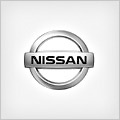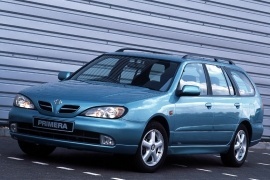
NISSAN Primera Break
Generations Timeline, Specs and Pictures

The third generation of the Primera was an unusual-looking car, and, strangely, the station wagon version looked more classy than its sedan brother.
With its complicated shape, the third generation of the Primera provided features that were not even on the options list for much more expensive premium vehicles. On top of that, the carmaker’s reliable products earned some extra points in front of its customers. But that shape was just too bold.
First of all, the front was narrow, the hood was steeper than most of the cars on the market, and the wide windshield was too raked for the European’s taste. The station wagon’s extended roofline made the car look a little bit more conservative than the sedan. Its raked-forward tailgate was considered sporty. It was just like an extended hatchback, with a Kamm-back design.
Inside, Nissan broke the automotive design rules and planted the instrument cluster in the middle, closer to the windshield’s base. Its large dials for the speedometer and tachometer were flanked on the sides by the fuel level gauge and the coolant temperature. Even the rear-seat passengers could have read them. Depending on the option, Nissan installed a color screen for the infotainment unit on the center stack. It was not a touch-screen type. To access it, the carmaker placed several buttons and a joystick-like button. In the back, the 60/40 split-folding bench offered plenty of room for three passengers. It could expand the trunk size from 465 liters (16.4 cu-ft) to 1,670 liters (58.9 cu-ft).
Under the hood, Nissan installed a choice of four engines: three gasoline and one diesel powerplant ranged between 109 hp and 140 hp. The carmaker offered a four-speed automatic for the 1.8-liter engine and a CVT for the 2.0-liter unit.

Nissan refreshed the second generation of the Primera in 1999, and the carmaker claimed that it changed over 600 parts in it, enhancing it to a much higher level than its main competitors.
The changes affected all the body versions, including the station wagon. Nissan Europe focused on the car, reshaped it, and added some engineering tweaks in Germany and the U.K. to make the vehicle fit for the narrow streets and roads from the old continent.
On the outside, the carmaker introduced a new grille, sporting reshaped wings as a grille. Its headlights were new, following the bio-design trend, which was almost gone. It also offered an option for Xenon headlights, and that came with a standard washer in the bumper. In the lower side of the bumper, the carmaker included a broad grille flanked by two fog lights. At the back, the main change for the station wagon was on the taillights. They were enhanced and also received a new protective glass.
Inside, the carmaker continued its changes. The center stack featured a dedicated audio system, which was unique for each vehicle. Thus, it was useless to steal them. As an option, a 10-CD changer was added in the trunk and controlled via the sound system panel. Nissan changed the front seats and reshaped them with a sculptured back. Thus, it allowed the carmaker to increase the knee room for the rear-seat occupants by 5 cm (2”). But the trunk space remained the same with 430 liters (15.2 cu-ft) of space with the rear bench up and up to 1,650 liters (58.3 cu-ft) with the back seatback folded.
Under the hood, there were two essential novelties: a 1.8-liter engine and a CVT gearbox for the 2.0-liter powerplant.

Nissan introduced a second generation for the Primera in 1996, and it wasn’t very sure if it worth making it as a station wagon.
Soon after the launch of the Primera P11 in Europe, the carmaker noticed an increased demand for the hatchback version. Also, there was a higher demand for station wagons in Europe as well. Thus, Nissan took a leap of faith and produced the Estate version of its mid-size sedan.
When Nissan started to work on Primera’s second generation, its design department didn’t want to go wild with the rounded shapes of the new bio-design trend. It tried to stick to the classic styling targeting traditional customers. Thus, the Primera looked more like a late ’80s vehicle, with rounded edges and curved body panels. But Nissan did the Estate version right, completely changing the car behind the B-pillar. While the hatchback and the sedan shared the rear doors, the Wagon version was not. In the back, it was completely new, and that included the reshaped taillights and, obviously, the tailgate.
Inside, Nissan tried to create a form-follow-function design. Unlike many other carmakers from that era, it placed the radio-cassette player above the climate-control dials. The instrument cluster was rounded and stretched above the center stack. The carmaker installed a clever system with a flip-over base in the trunk that featured a plastic tray on a side and a flat, carpeted area on the other.
Under the hood, Nissan installed a choice of three engines: two with gasoline and one turbo-diesel. The car featured standard ABS and EBD (Electronic Brake Distribution) for the entire range.

Larger than both the hatch and the sedan, the wagon’s primary feature was its enormous trunk with a volume close to twice as much as that of other Primeras.
Kept high above the ground thanks to an increased ground clearance and capable of a greater payload, the Primera wagon was a good choice for a touring car with comfortable seating for 5 and plenty of room for luggage. Powered by the same engine range comprised of two gasoline units and one Diesel plant with displacements of 1597 cc and 1998 cc respectively, the Wagon was a reliable, roomy vehicle with wide windows that increased interior ambiance.























































